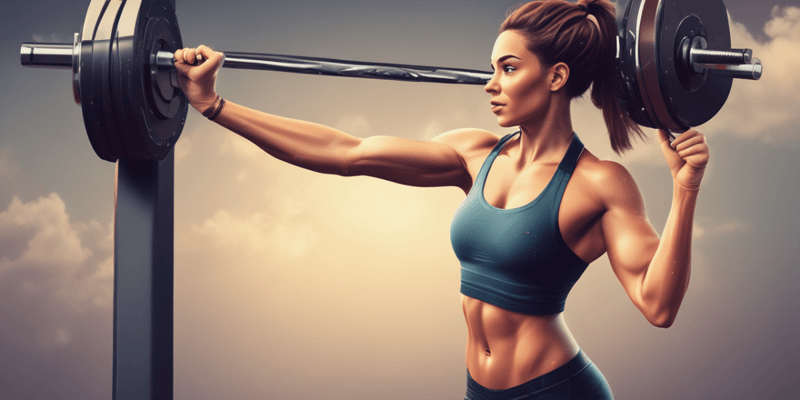12 Questions
What is the primary goal of Phase 1 in strength training?
To build up the body's tolerance to higher volumes of strength training
Which type of conditioning is associated with high-intensity, short-duration exercises?
Anaerobic interval training
What is the result of building up longer duration, lower intensity forms of conditioning?
Increased aerobic capacity
What is a key aspect of Phase 1 in strength training?
Building up the body's tolerance to higher volumes of strength training
What is the outcome of progressing through different forms of conditioning?
Capacity building and eventually peaking with higher intensity short duration maximal anaerobic power intervals
What is the primary benefit of re-introducing horizontal and vertical push movements at a lower volume?
To avoid overloading the shoulder and causing re-injury
What is the purpose of focusing on increasing capacity slowly?
To reduce the risk of overloading the shoulder
What is the primary focus of Phase 1 in strength training?
Increasing aerobic capacity and conditioning
What is the primary goal of Phase 2 in strength training?
Advancing accessory movements and increasing load
What is the main focus of conditioning exercises in Phase 2?
Building anaerobic power and speed
What is the ultimate goal of capacity building in strength training?
Improving overall conditioning and buffering fatigue
What is the primary focus of Phase 1 and Phase 2 in terms of strength training?
Increasing aerobic capacity and conditioning
Study Notes
Phases of Training
- There are two phases of training: Phase 1 and Phase 2.
- Phase 1 focuses on capacity building, increasing the body's tolerance to higher volumes of strength training, and improving lifting technique.
- In Phase 1, the aim is to build up the body's conditioning simultaneously, increasing aerobic capacity.
Phase 1: Capacity Building
- The focus is on building up the body's tolerance to higher volumes of strength training.
- Improving lifting technique is a key aspect of Phase 1.
- Confidence in the gym is also a goal of this phase.
- Horizontal and vertical push movements are reduced and replaced with specific shoulder strengthening movements.
Phase 2: Intensifying
- In Phase 2, the training becomes more intense, with a focus on increasing the load used.
- Accessory movements are advanced in this phase.
- Conditioning becomes more focused on increasing speed or power for medium-length intervals.
- The body's ability to buffer fatigue during higher work rates is also a focus of Phase 2.
Training Considerations
- Training can be adapted to accommodate busy schedules or high-rated stress.
- In such cases, lower intensity forms of conditioning are used, with a progression to more anaerobic interval-style training.
- Finally, the training peaks with higher intensity short-duration maximal anaerobic power intervals.
Managing Injuries
- In the case of a shoulder injury, Phase 1 focuses on no horizontal pressing, with replacement exercises such as shoulder external, internal, and abduction rotations.
- The goal is to avoid overloading the shoulder and causing re-injury.
Learn about the first phase of training, focusing on building capacity, increasing tolerance to strength training, and improving lifting technique. This phase also aims to build up the body's conditioning and aerobic capacity.
Make Your Own Quizzes and Flashcards
Convert your notes into interactive study material.
Get started for free



